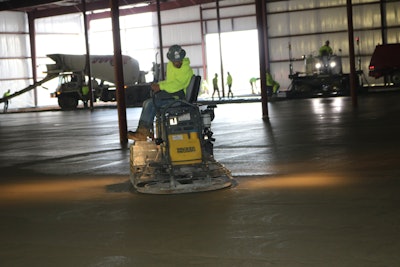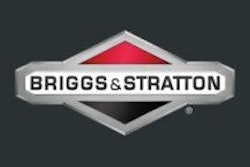
Milis Flatwork, which specializes in large scale concrete pours, was hired as the concrete contractor for a recent 40,000-sq.-ft. warehouse extension for a plastics company in Kaukauna, WI.The project required the contractor to arrive a 4:15 a.m. to start the pour at 5:00 a.m., when about 70 trucks would begin to arrive carrying just under 700 cu. yds. of concrete.
The 70 trucks arrived like clockwork, allowing Dylan Milis, owner/operator of Milis Flatwork, and his crew to have all the concrete placed by about 1:00 pm. Throughout the pour, Milis operated his new Somero laser screed and was confident that they would achieve a flat floor. “We don’t have any specific FF numbers, but I would anticipate we will hit well over 65 for FF," he states. "The floor will not be tested, since there are no specs, but it will be a quality flat floor.”
Finishing the Work
On a job this size, Milis has a well-planned system for the finishing process. “We put down the concrete with a laser screed to get it as flat and level as possible, which definitely aids in a flatter floor,” he explains. "Then, we pan the floor twice with two machines that have pans on them. After we pan the floor, we run some combo blades on it, and then we finish it out with plastic blades. This will be an exposed floor, so we’ll put a nice shine on it.”
Luke Sevcik, Wacker Neuson product application/training specialist and ACI-certified flatwork finisher and examiner, confirms that quality floors start with the right process. “When pouring large block placements, as in the case here, laser screeds and ride-on trowels with highly skilled operators will yield high FF numbers, even when not specified," he indicates. "It’s good practice to always follow best methods every time you pour to keep your skills honed and be prepared for a job that does call for high FF numbers.".
Milis uses Wacker Neuson ride-on and walk-behind trowels for this finishing work. “On this job, we have four 8-footers (CRT48) and one 6-footer (CRT36); one of them is a hydro machine that we do a lot of panning with, and the others are stick machines. We have a mixture of Kubota- and Vanguard-powered machines, which are both good engines. We also have a walk-behind edging machine doing the edges. We definitely like the fuel-injected Kubota engines...
"Some of the guys like the hydro machine," he continues. "If they are doing big floors like this, they don’t get operator fatigue. The hydro machine has dual settings so that’s nice depending on the type of floor you’re on and how fast you are moving. We have it set up that each machine has its process and certain operators run those machines."
Achieving a quality floor also depends on the quality of the finishing equipment, and Milis has found confidence in Wacker Neuson’s flatwork finishing line. “Originally we bought Wacker (Neuson) because they were made locally; they are made 100 miles south of us in Milwaukee (Menomonee Falls, WI),” Milis comments. “We went down to the factory, toured the plant when we bought them. We saw how they were put together -- the quality control, very high-quality machines. And now we continue to purchase them, because we don’t have any problems with our machines, so why change? We have had minimal to no problems, they are priced competitively and we’ve had a good experience.”
Milis Flatwork purchased the trowels from its local dealer, Lincoln Contractors Supply.
Training is Important
Milis attributes much of his company's success to his crew’s understanding of the entire concrete process. He has sent many of the staff through Wacker Neuson’s Industrial/Commercial Concrete Floors two-day training program.
“We send our guys down to the school and they get some hands-on experience, and it also teaches them the specifics on how to make flat floors, how to edge properly, how to run equipment, things of that sort," he points out. "They know what to anticipate and they know how the process works when they are doing a commercial floor.”
Sevcik leads Wacker Neuson’s concrete training program and knows the importance of well-trained operators. “The training we offer at the Wacker Neuson University has proven to be a valuable resource for both experienced and beginning concrete finishers. Operators enhance their skills in not only finishing commercial floors, but the entire process from the pre-pour planning to curing," he notes. "By training on the latest finishing techniques, following ACI-recommended practices and using the best finishing products available, contractors increase their productivity, FF and FL numbers and overall quality of their product.”
Milis says that the training has helped his business. “It has improved speed and final quality of the product when we are done. It definitely improved final quality and just the whole process in general," he states. "It starts at the beginning. If everything is done right at the beginning, it eases the rest of the way through.”
As for the 40,000-sq.-ft. warehouse expansion, planning, training and the right equipment provided a quality flat floor that was finished on time, just like clockwork.
Ed. Note: Julie Shuster is with Wacker Neuson in the Marketing Communications Department.


















